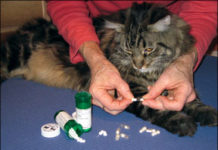Neighborhoods and Shelters Researchers studied the effect of distance and neighborhood-level demographics on the number of pet adoptions from an animal shelter (“Use of geospatial neighborhood control locations for epidemiological analysis of community-level pet adoption patterns,” American Journal of Veterinary Research, 2010). The methods used to perform the study included client segmentation, geospatial tools, and epidemiological techniques that evaluated locations of 1,563 adoptions from an animal shelter in eastern Massachusetts. Proximity to the shelter was found to be strongly associated with adoption. Locations that were less than six miles from the shelter having higher block group median income, or having a greater proportion of households that were composed of married couples with children in the block group, were associated with increased odds of being an adoption location. Neighborhood lifestyle characteristics also influenced shelter adoption patterns. This study explored pet adoptions as one aspect of shelter operations. There are other potential applications of this type of technology and analysis for shelter outreach in identifying under-served areas for mobile spay-neuter programs, improvement of allocation of animal control resources, better targeting of media messages about the shelter, along with other possibilities. More About Cardiomyopathy Arterial thromboembolism (ATE) is a serious – and frequently fatal – complication of cardiomyopathy in cats. Thromboemboli are believed to originate from clots in the left atrium or left atrial appendage, but the factors causing clot formation are not fully understood. In this study (“Hypercoagulability in cats with cardiomyopathy,” Journal of Veterinary Internal Medicine), the researchers hypothesized that cats with cardiomyopathy develop ATE because they are in a systemic hypercoagulable state or have underlying endothelial (arterial or endocardial) injury. Healthy cats and three groups of cats with cardiomyopathy were studied. Group 1 cats had left atrial enlargement (LAE) only. Group 2 cats had LAE with spontaneous echocardiographic contrast, atrial thrombi or both. Group 3 cats had acute ATE with LAE. Coagulation status was assessed in all three groups, including fibroginogen, Factor VIII, antithrombin, thrombin-antithrombin complex (TAT) and D-dimer concentrations. The 3 groups of cats with cardiac disease had higher median fibrinogen concentrations than did the healthy cats. Criteria of hypercoagulability were found exclusively in cats from group 2 and group 3. Hypercoagulability was not associated with left atrial size or congestive heart failure. Systemic hypercoagulability is evident in many cats with cardiomyopathy, often without concurrent congestive heart failure or overt ATE, and may represent a risk factor for ATE. The researchers concluded that the pathogenesis of ATE is multifactorial and therefore treatment and prevention of this syndrome might involve drug combinations modulating hemostasis and inflammatory pathways. Hyperthyroidism Treatment The medical management of feline hyperthyroidism – the most common endocrine disorder in middle-aged and older cats – often includes the antithyroid drug methimazole. It can be used either before surgery (thyroidectomy) or radioiodine treatment, or for long-term management of the disease. Carbimazole is rapidly metabolized to methimazole in vivo. This cross-over study (“Serum concentrations of methimazole in cats after a single oral dose of controlled-release carbimazole or sugar-coated methimazole [thiamazole]” Veterinary Therapeutics, 2010) of six normal cats compared a single oral dose of either a controlled-release carbimazole tablet or a sugar-coated methimazole tablet. Both formulations are approved for use in cats and were found to be well-tolerated by the cats in the study. The pharmacokinetic values for the two treatments were similar when differences in effective methimazole dose were taken into consideration. Both drugs were reported to have relatively short plasma half-lives, which would seem to support either once or twice daily dosing for either. Methimazole accumulates in the thyroid gland so that antithyroid effects extend beyond (possibly up to 24 hours) the duration of elevated plasma levels. Therefore, the short half-life of three hours for both controlled-release carbimazole and sugar-coated methimazole tablets is consistent with current practice recommendations for divided daily dosing, although once-daily dosing may be appropriate for maintenance therapy in some cats.



